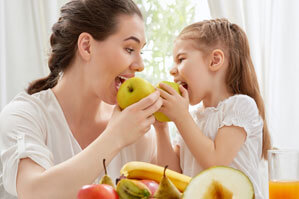5 tips to influence healthy food choices
Are you having a hard time getting your kids to choose the healthier food option? Do your kids not like to eat vegetables? Researchers from Cornell University have been studying behavioral economics and how parents as well as child care providers and schools can use these techniques to influence their children’s food choices — without your kids knowing!
I do not have kids personally; however, as a pediatric dietitian I see a lot of children who don’t always like to make the healthiest food choices. While many people will tell the parents of these children to simply eliminate the unhealthy foods from the house, it is not always that easy. This option can potentially lead to unproductive behaviors in children such as hoarding food and/or binging on those food items when they are available. According to Cornell University, the answer is not elimination, but simply redesign.
Behavioral economics is an approach that helps identify behavioral triggers that lead to the choice of eating healthier foods and healthier amounts of food. These techniques are already used in some school lunchrooms and many are finding these ideas helpful for use in the home as well. So what exactly do you need to do to get your kids to CHOOSE the vegetables? Two techniques include rearranging the items that are currently offered and using descriptive names. These ideas help influence choice, improve perceptions of foods and possibly help introduce unfamiliar foods.
Give these techniques a try:
- Put the “unhealthy” snacks away and keep healthy options readily available. Have a fruit bowl on the table with apples, bananas, oranges, etc. for kids to easily grab after school. Cut up vegetables and have them ready to eat in the fridge. Make some tasty dips to go along with their snack!
- If you have a snack cupboard that is easily accessible to a 3-foot youngster, make sure the snacks at eye level are ones you want them to have more frequently. Keep the fruit snacks and granola bars on the top shelf out of direct eye sight to limit consumption of these items. You could make snack sized grab bags of trail mix with nuts, dried fruits and a whole grain cereal to keep in the cupboard as a healthy option.
- Keep milk and water in the front of the fridge and push the juice and other sugar-sweetened beverages towards the back where they are somewhat hidden. Many times kids will pick the option they see first. This is a great idea for other snacks, too, such as vegetables, yogurt and string cheese!
- Get the kids involved in planning dinner! This will likely increase the chances they will eat the foods prepared! Have your kids help with the shopping list, pick out produce in the grocery store or even assist in cooking the meal.
- Another fun way to get kids involved is to come up with creative names for your fruits and vegetables. Examples could be “power punch broccoli” or “tiny tasty tree tops”. You may be surprised at what an imagination your child has!
All this sounds good and simple right? Just remember that these changes should be small and somewhat unnoticeable to your kiddos. A great place to start is to just make one change! You may be surprised at how your family naturally responds.
